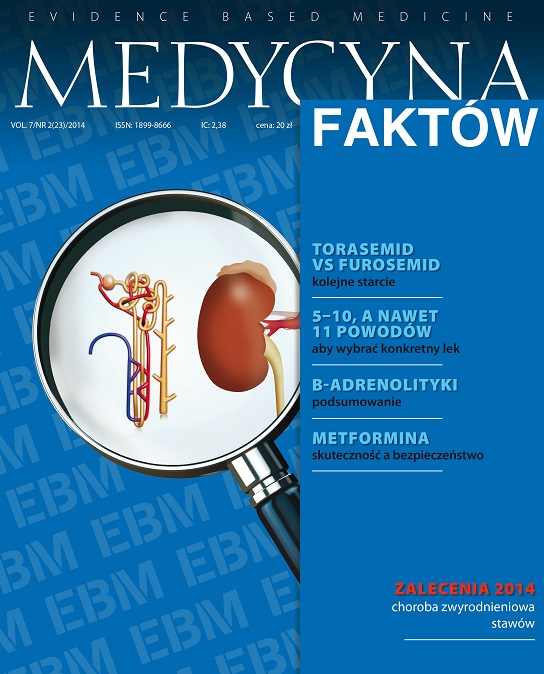Dziesięć powodów, dla których warto stosować amoksycylinę z kwasem klawulanowym Artykuł przeglądowy
##plugins.themes.bootstrap3.article.main##
Abstrakt
Połączenie amoksycyliny z kwasem klawulanowym znacznie poszerzyło jej zakres działania przeciwbakteryjnego. Antybiotyk ten dobrze penetruje do większości tkanek, co umożliwia jego skuteczne zastosowanie w leczeniu zakażeń. Skuteczne wchłanianie się tej substancji z przewodu pokarmowego umożliwia jej wygodne wykorzystanie w lecznictwie ambulatoryjnym. Amoksycylina z kwasem klawulanowym jest lekiem bezpiecznym, o niewielkiej toksyczności narządowej, w związku z tym może być również stosowana przez pacjentki będące w ciąży oraz karmiące. Antybiotyk ten od lat z powodzeniem wykorzystywany jest do eradykacji chorób górnego odcinka przewodu pokarmowego, w przebiegu których stwierdzono obecność Helicobacter pylori. Preparat ten dzięki swoim właściwościom synergicznym w połączeniu z innymi antybiotykami, takimi jak fluorochinolony czy aminoglikozydy, znacząco zwiększa skuteczność działania przeciwbakteryjnego.
##plugins.themes.bootstrap3.article.details##
Copyright © by Medical Education. All rights reserved.
Bibliografia
2. Dzierżanowska D., Jurkiewicz D., Zielnik-Jurkiewicz B.: Zakażenia w otolaryngologii. α-medica Press, Bielsko-Biała 2002; 220-226.
3. Yin H., Xiang S., Zheng J. et al.: Induction of holomycin production and complex metabolic changes by the argR mutation in Streptomyces clavuligerus NP1. Appl. Environ. Microbiol. 2012; 78(9): 3431-3441.
4. Kostowski W., Herman Z.S.: Farmakologia. Wyd. III. T. 2. PZWL Warszawa 2010; 309.
5. Dzierżanowska D., Dzierżanowska-Fangrat K.: Przewodnik antybiotykoterapii 2011. α-medica Press, Bielsko-Biała, 2011; 70-71 i 80-82.
6. Holten K.B., Onusko E.M.: Appropriate prescribing of oral beta-lactam antibiotics. Am. Fam. Physician. 2000; 62(3): 611-620.
7. Singh M., Kambalimath D.H., Gupta K.C.: Management of odontogenic space infection with microbiology study. J. Oral and Maxillofac. Surg. 2014; 13(2): 133-139.
8. Smuszkiewicz P., Szałek E., Tomczak H. et al.: Zasady farmakokinetyczno-farmakodynamiczne stosowania antybiotyków u chorych septycznych. Anestezjologia Intensywna Terapia 2007; 39(3): 166-74.
9. Craig WA., Andes D.: Pharmacokinetics and pharmacodynamics of antibiotics in otitis media. Pediatr. Infect. Dis. J. 1996; 15(3): 255-259.
10. American Academy of Pediatrics Subcommittee on Management of Acute Otitis Media: Diagnosis and management of acute otitis media. Pediatrics. 2004; 113(5): 1451-1465.
11. Chu C.H., Wang M.C., Lin L.Y. et al.: High-dose amoxicillin with clavulanate for the treatment of acute otitis media in children. Scientific World Journal 2014; 2014: ID 965096, 6 pages.
12. Alahdab Y.O., Kalayci C.: Helicobacter pylori: Management in 2013. World J. Gastroenterol. 2014; 20(18): 5302-5307.
13. Berrutti M., Astegiano M., Smedile A. et al.: Efficacy of amoxycillin plus clavulanic acid-based triple therapy for Helicobacter pylori eradication: a retrospective study. Panminerva Med. 2010; 52(4): 361-362.
14. Cennamo V., Morace C., Ceroni L., Fabbri C.: On the efficacy of penicillins for Helicobacter pylori eradication. Panminerva Med. 2011; 53(2): 137.
15. Netzer R.O., Zollinger E., Seiler C., Cerny A.: Infective endocarditis: clinical spectrum, presentation and outcome. An analysis of 212 cases
1980-1995. Heart 2000; 84(1): 25-30.
16. Banach M., Ostrowski S., Okoński P.: Infekcyjne zapalenie wsierdzia – aktualny stan wiedzy. Przewodnik Lekarza 2004; 10(7): 80-88.
17. Slavin M.A., Thursky K.A.: Outpatient therapy for fever and neutropenia is safe but implementation is the key. J. Clin. Oncol. 2013; 31(9): 1128-1129.
